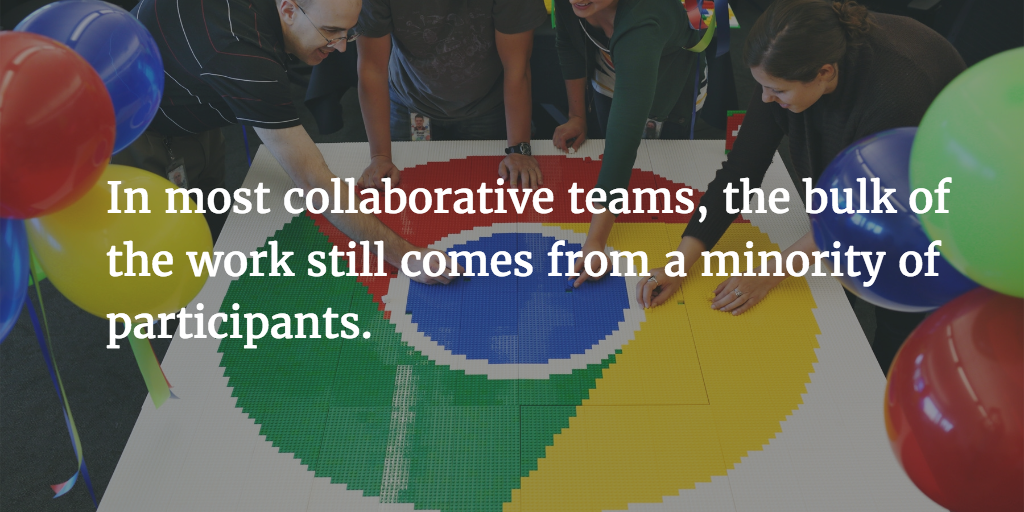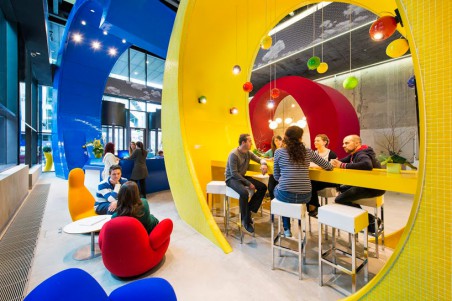This week’s article is a guest post by Paul Berkovic. Paul is Co-founder and CMO at ScribblePost (productivity software for capturing and sharing task and project information with anyone, anywhere).

We do a lot of collaborating these days. But despite the number of open offices, designated “thinking” areas, and our managerial focus on small teams, we still haven’t mastered collaborative work.
In fact, we’re really bad at it.
The point of collaborating is to get everyone in a group involved and exercising their strengths. But according to the Harvard Business Review, “In most cases, 20% to 35% of value-added collaborations come from only 3% to 5% of employees.” In most collaborative teams, the bulk of the work still comes from a minority of participants.
In response to this imbalance in their own organization, Google launched Project Aristotle, an internal research project studying Google teams to discover why some were superior collaborators.
Google has a known penchant for quantifying everything. Project Aristotle expected to find something quantifiable, like the optimal team size or the most productive structure for group meetings. But Project Aristotle hit the ultimate irony: the key to collaboration is not a quantifiable. In fact, it wasn’t even codified. The best teams don’t have a measurable, highly visible solution to collaboration—they have an unwritten social code.
Google’s secret social code
That social code was tacitly agreed upon, and usually instituted by the managers: the most collaborative teams, even if they have a single leader or moderator, were ones where everyone spoke equally.

This fact wasn’t written down anywhere, or decided upon by management. The teams themselves didn’t even notice they were doing it. But researchers recognized that less successful teams were the ones where a manager spoke 80% of the time or more. In successful collaborative teams, everyone engaged in “conversational turn-taking”—one of the most human things we do— whether it was through a daily standup or a monthly check-in.
Since the conversation wasn’t monopolized by one person, they were able to ask clarifying questions and give their input. In situations where only one person speaks, team members didn’t feel comfortable voicing their ideas, chiming in on other peoples’, or correcting their more vocal team members’ mistakes. Imbalanced communication, in short, defeated the purpose of collaborating in the first place.
Equal speaking, on the other hand, has huge benefits. As the study concluded, individuals on Google teams with an “equal speaking” social code were:
- Less likely to leave their job at Google
- More likely to harness the power of diverse ideas
- Bring in more revenue from their efforts
- Rated by their managers as “effective” twice as often their peers
Let the people speak!
The most important impact of everyone speaking equally was a phenomenon called psychological safety. Harvard Business School professor Amy Edmondson defines psychological safety as the feeling of security in a group setting that allows everyone the “comfort to contribute.” It’s the condition under which everyone feels secure enough to speak up, knowing they won’t be mocked or shut down by their team members.
Without psychological safety, team members don’t contribute openly. Without psychological safety, there’s no true collaboration.
In their study examining internal teams, Google found that it was incredibly important in whether people felt able to contribute equally to the team. In order to assess this, they asked employees this:
Did you feel like you could ask what the goal was without the risk of sounding like you’re the only one out of the loop? Or did you opt for continuing without clarifying anything, in order to avoid being perceived as someone who is unaware?
It should be no surprise, then, that the Google employees who felt encouraged to ask questions and get clarity witnessed much better collaboration. Because they felt psychological safety, they exhibited more leads to interpersonal risk-taking. When your team feels comfortable taking risks, they’ll contribute more. They’ll throw out that idea out of left field without fear that someone will mock them. They’ll collaborate openly and willingly.
Great teams are borderless
Dubai Airports wanted to improve customer experience. The company trained their staff and communicated with everyone about how this could be done, but they kept failing. The customers still weren’t happy. Like high-functioning Google teams, the customer experience team worked well internally. They communicated well and spoke equally. They couldn’t figure out what was wrong.

Eventually, the customer experience team realized that in order to improve overall customer experience, they didn’t need to perfect internal collaboration or tools—they had to improve inter-team collaboration.
It couldn’t just be airport employees who were in on the mission to improve customer experience—it had to be workers in every rental car station, duty-free store, and restaurant inside, even if they weren’t employed by Dubai Airports. Internal collaboration, they realized, is nothing if you’re working with other teams and can’t communicate your findings with them.
Collaboration—and the role of psychological safety and “conversational turn-taking,” like Project Aristotle concluded—does not just apply to your immediate team—they apply to everyone you work with, in some capacity.
It’s something an MIT Sloan School of Business Study concluded as well—the most successful teams are the ones who communicate well internally and externally.
Whose team are you on?
It’s easy to forget about this crucial element of communicating outside of your immediate team. When we’re in an office environment and primarily interacting with a handful of people—the ones you see every day and have lunch with—we tend to put up blinders.
If you’re like most people, you work in a lot of different collaborative groups—within your office, organizations your company collaborates with, and freelancers. We’re all on a lot of teams, they’re just pseudo-invisible.
We need to recognize the importance of inter-team communication. In order to best communicate with all teams, as the Dubai Airport team recognized, we need to understand three important things:
- Who the point-person is for cross-team communication
- What medium they’re communicating in—is it a company’s internal tool? If so, how often should the external team check for updates, or will they be forwarded to them?
- What the goals are of these two teams working together
Communicating across teams, not just within them, allowed Dubai Airports to deliver a superior customer experience.
Team communication is your secret weapon
If your team isn’t communicating well, they’re essentially an untapped resource. Your quietest team members might be sitting on strengths you don’t even know about, or there might be miscommunication between teams that are causing collaboration and creativity to suffer. It’s your job as manager to create a team environment that allows everyone to exercise all their strengths.
For Google, that meant that it wasn’t just a good idea to create psychological safety within teams—it was an imperative. In order to keep their competitive edge, they didn’t need to just have the best analytic tools or the top talent in the world. They needed to be the world’s best collaborators. And it paid off.
A small change to your team’s social codes—as well as all the “pseudo-invisible” teams you’re on—can reap huge benefits in profitability, team happiness, and value-added insights. Google’s research made it clear that a lot of teams aren’t doing this at the moment, even though it’s an easy fix. Finding ways to create these social codes is absolutely necessary to maintain a competitive edge—it’s just a matter of implementing your team’s own “unwritten rule.”
Paul Berkovic is Co-founder and CMO at ScribblePost. Thanks for sharing, Paul!
